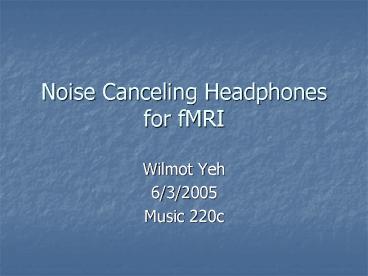Noise Canceling Headphones for fMRI - PowerPoint PPT Presentation
Title:
Noise Canceling Headphones for fMRI
Description:
Cut and file. One pair of stators per transducer. As flat as possible. No ... Spacers need to be cut so there is no chance of short-circuit. Plastic-epoxy glue ... – PowerPoint PPT presentation
Number of Views:53
Avg rating:3.0/5.0
Title: Noise Canceling Headphones for fMRI
1
Noise Canceling Headphones for fMRI
- Wilmot Yeh
- 6/3/2005
- Music 220c
2
Project Overview
- To aid studies in music and voice cognition
- Lack of existing solutions that provide good
enough noise reduction - Lack of existing solutions that provide
high-quality sound
3
Significant Obstacles
- No ferrous metals (minimum of any metal)
- No Dynamic (moving coil) transducers
- Very loud scan noise
- Dependent on scanning parameters
- 103dB from 1kHz to 7kHz
- RF Interference/Drain
- Scanning accomplished by RF energy at 64MHz and
128MHz - Drain and interference results in diminished
resolution/accuracy
4
Existing Approaches
- Sound delivery
- Pneumatic
- Piezoelectric
- Electrostatic
- Noise Reduction
- Passive
- Active (Chamber)
- Active (Headset)
Only electrostatic drivers are capable of
producing accurate, full-range sound Active
in-headset noise canceling achieves the greatest
and most consistent noise reduction.
5
Electrostatic Transducer
Stators ( /- 350V-1000V)
- Charged, low-mass diaphragm suspended between
stators carrying a differential audio signal - As the charge on the stators change, force is
exerted on the diaphragm
Spacers (dielectric)
Diaphragm (250V-600V static)
(Voltages are for headphones)
6
Construction
- Materials
- Perforated aluminum sheeting (stators)
- Ideally coated/drilled circuit board
- 0.5 mil Mylar film (diaphragm)
- 20 mil Polycarbonate sheeting (spacers)
- Graphite, Foil, Glue, etc
7
Cut and file
- One pair of stators per transducer
- As flat as possible
- No burrs/bumps
8
Stretching the Mylar
- Mylar must be stretched flat
- Wide range of tension
- Depends on electronics
9
Adding resistive film
- Can be done with variety of substances
- Graphite
- Soap
- Resistances of 15 MOhms
- Allow charge/prevent failure from arcing
10
Cutting spacers/Assembly
- Spacers need to be cut so there is no chance of
short-circuit - Plastic-epoxy glue
- Aluminum foil lead from diaphragm
11
Finished transducer
- Mounted (not yet) inside an industrial-application
ear protector (29dB NRR) - Enough room for noise-canceling pickup and
compact RFI filter
12
Electronics
- Requires a high-voltage bias and high voltage
signal - Bias at 250V-600V, signal from /- 300V 1000V
- Capable of outputting enough power to cancel
103dB of broadband noise - Capable of working with high resistance cabling
and robust RFI filters/chokes
13
Options
14
Remaining Issues
- Noise canceling
- Closed-loop system
- Electret capsule from 220a (non-ferrous)
- Simple opamp-based circuitry (external)
- RF Interference/Drain
- RF chokes
- Bypass capacitor network































